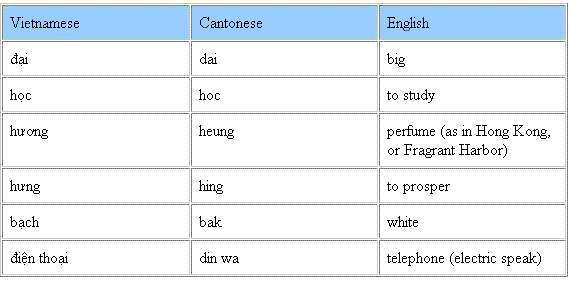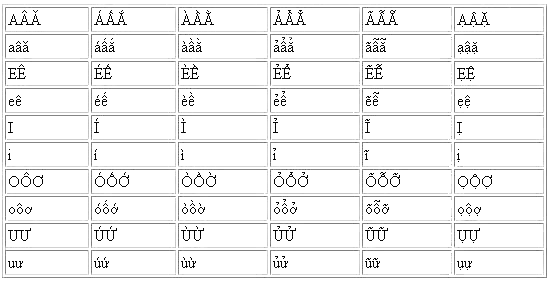
In books about language, I've always read that Vietnamese belongs to the Mon-Khmer family, a southeast Asian group. This tells so little of the story that it's positively misleading. The Vietnamese language may have started that way, but its current form is the product of 1,000 years of Chinese rule.
One book says that Vietnamese was originally non-tonal, but now it has six tones. It also turns out that a shocking 60 percent of the vocabulary comes from Chinese as well. The situation is similar to English, which the books say is a Germanic language. With its extensive French influence, that too is hard to believe.
The first inkling came when I started to recognize words in Vietnamese. I've never studied Vietnamese and I don't know any, so to recognize words in a language I don't know struck me as extremely strange. Nor do I have any recollections of a prior life. The only explanation was that the words were similar to Chinese, even though I had read that the two languages were unrelated. Political correctness told me not to compare Vietnam with China, but the more Vietnamese I heard the harder it was not to.
I studied Cantonese for half a year, and though I'm no genius in Chinese, I know a bunch of words. By coincidence, Cantonese is an older form of Chinese than Mandarin, and more similar to the medieval, southern Chinese that left its mark on Vietnam. Here were some of the clues:

I'm sure I could come up with many more examples, if only I knew the two languages I'm comparing. In the best scholarly tradition, I'm talking with complete authority on not one, but two things I don't know. In any case, the words in question are pretty basic, which points to the high level of infiltration.
Grammar
The grammar is pretty much the same. Both have:
There are also differences to report.
Tones
Both Chinese and Vietnamese are monosyllabic, and both have tones. In both languages, every word is a single syllable. To get the largest possible amount of syllables, these languages are rich in vowels. But even so, you still run out of syllables after a while. The solution is that each syllable does extra duty with the use of tones. If you can't expand horizontally with longer words, you expand vertically instead by varying the voice. As you pronounce the vowel, the voice rises or falls in pitch, and these tones are heard as part of the word. Mandarin has 4 tones, Cantonese has 8, and Vietnamese has 6. By the way, Vietnamese popular songs will rhyme phonetically, but songwriters don't feel the need to match the tones.
Phonetics
To my ear, Vietnamese sounds like two phonetic systems slapped together. There's one that sounds like Chinese, and there's one that doesn't.
The one that does sounds like Chinese sounds like southern Chinese, to the point where people mistake the letter "n" and the letter "l" (originally, both letters were short, pronounced with the tip of the tongue behind the upper teeth, so it's not that far-fetched that they should be seen as similar). It's apparent when people speak in English and say things like "I go to schoon".
When we were in Hue, we saw a concert of Vietnamese court music. The leader of the group spoke in a way that sounded like Mandarin (lots of "shh" sounds of different depth). My Vietnamese-speaking travel companion remarked on how elegant her speech was. The Vietnamese emperors modeled themselves on the Chinese emperors, so it wouldn't be surprising if the speech were part of that.
The other system has some more nasal consonants, like an implosive-sounding "b" with an "m" in front of it. This "b" sounds like it goes from the outside in, rather than the normal way you pronounce a "b" from the inside out. There's also a bouncy cadence that happens when these letters are present.
From north to south there are various regional accents. For instance, my friend's name "Duyen" is pronounced "Zooen" in the north, and "Yooen" in the south. Where people in the north and the south can understand each other pretty well once they know the conversions, no one can understand the accent in Hue. Hue also has its own dialect. Not only are the words pronounced differently, but the tonal system is different as well. There are five tones rather than the usual six.
The Alphabet
Until the 18th century, Vietnamese was written using Chinese characters, either pure Chinese, or a locally adapted "demotic" version. Portuguese missionaries designed a Latin alphabet for the Vietnamese language to teach the Bible, and duplicating a quirk of Portuguese, the letters "nh" are pronounced "ny".
In hindsight, the missionaries could have saved a lot of time and trouble by circulating Bibles in Chinese, reaching the world's largest market first, and then reaching Vietnam as a bonus. In any case they would have had to teach the peasants to read, so the alphabet was a good thing.
An alphabet makes the difference between several weeks' learning and several years. Chinese writing is composed of 214 radicals (components) which have to do with the meaning of the word. Although there are clues about how the word might sound, you can't be sure until someone tells you. In Vietnamese you know the pronunciation right away.
This sounds ideal, so there has to be a catch somewhere. It's a big one. The vowels are utterly fiendish. The sounds of the vowels are modified with circumflexes - right-side up and upside-down - and in the case of the letters "o" and "u", with hooks on the side.
![]()
And as they say on television, "But wait -- there's more!" Because Vietnamese is a tonal language, each of these vowels has six possible tones, and six possible versions:
![]()
What that means is that each vowel can have not one, but two diacritics, unusual for the Roman alphabet, but perfectly in character for Vietnam. It's like the Vietnamese table that's loaded with small dishes, or the Vietnamese motorcycle balancing two more things than the rider can carry. There are a startling 66 possibilities, 72 if you count the letter "y":

If you think that no one will notice if you leave the diacritics out, guess again. And you have to put these marks on the capital letters as well – in Spanish you can leave them out, but here you have no option. The good side of all this is that typesetters are respected members of society, and their good work makes for eye-catching pages. This top-laden typography will make even the most boring article look like a Hollywood musical starring Carmen Miranda.
Also quirky is the Vietnamese way of spelling things out loud. Because there are so many possible spellings, there are that many possible mistakes. To make sure you get the message, they've put in some extra redundancy. To spell a word in Vietnamese you say each new letter, and then go back to the beginning of the word and pronounce it up to the point with that letter. For instance, to spell the English word "hat" you would say "aitch huh / a ha / tee hat". Again, what luck that each word in Vietnamese is a single syllable.
Needless to say, the Internet has totally butchered the Vietnamese language, where the character set is US ASCII and no diacritics are available. The advantage, of course, is that it takes less than a week to write a note that says "Hello, how are you?". There's a fair market in Vietnamese word processors, since as you might guess, choosing the right vowel is nothing short of diabolical.
In the consonant department there are a few oddities as well. The letter "D" isn't pronounced like a "D" (it's pronounced either like a "Z" or a "Y"). But you still need something that sounds like a "D", because that sound does exist. The "D-that-sounds-like-a-D" was instituted as
![]()
which looks like the Icelandic letter "thorn". Phonetically, I think this is a major crime, and for adding this confusion, the perpetrators should be tracked down and brought to justice. Fortunately though, the average Vietnamese doesn't have an awful lot to do with Iceland.
Other oddities: the initial letter "c" is voiced like "g", and the letters "tr" sound like "ch". What this means is that Vietnamese for "thank you"
![]()
is pronounced, "gam oon". The name for China, which the Chinese call "Chung Kuo", is pronounced very similarly in Vietnamese, but written as
![]()
and the "q" is also a "g". For many years I went to a restaurant called Nha Trang. To my embarrassment, I found out in Vietnam that it's pronounced "Nya Chang". It's reassuring to find out that the staff were too nice to correct me.
So there, folks, in a nutshell, is the Vietnamese language. I'll have even more to say after I've learned it.